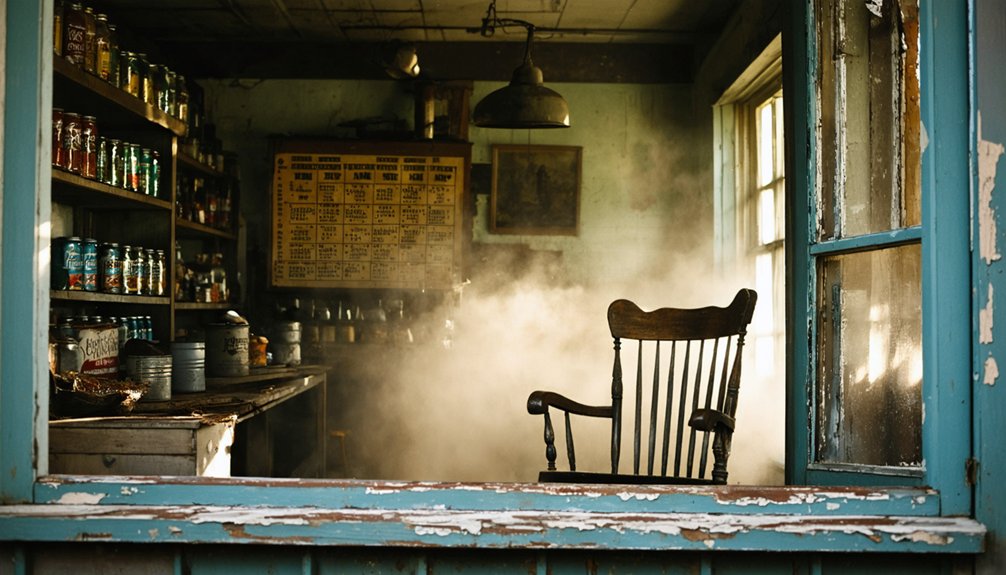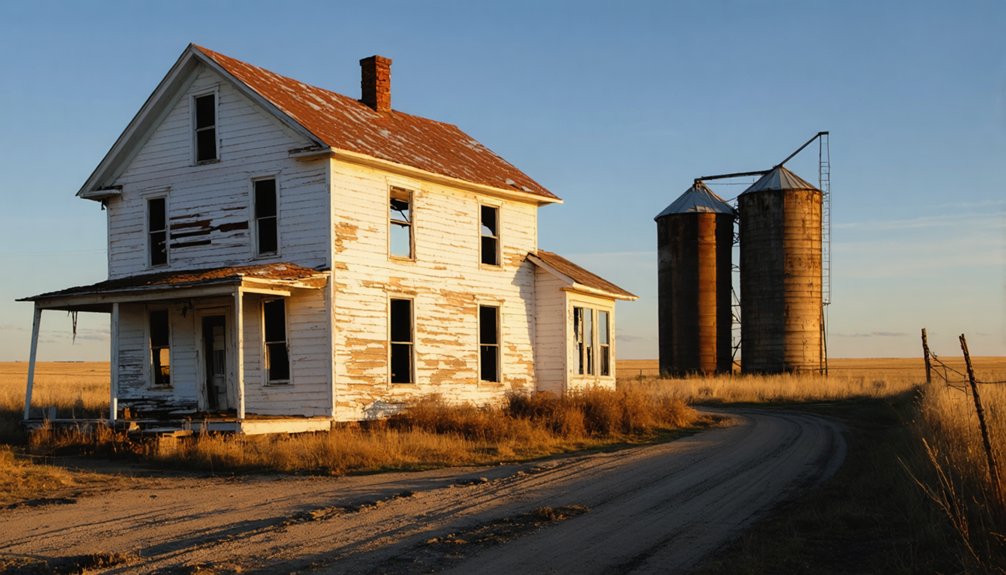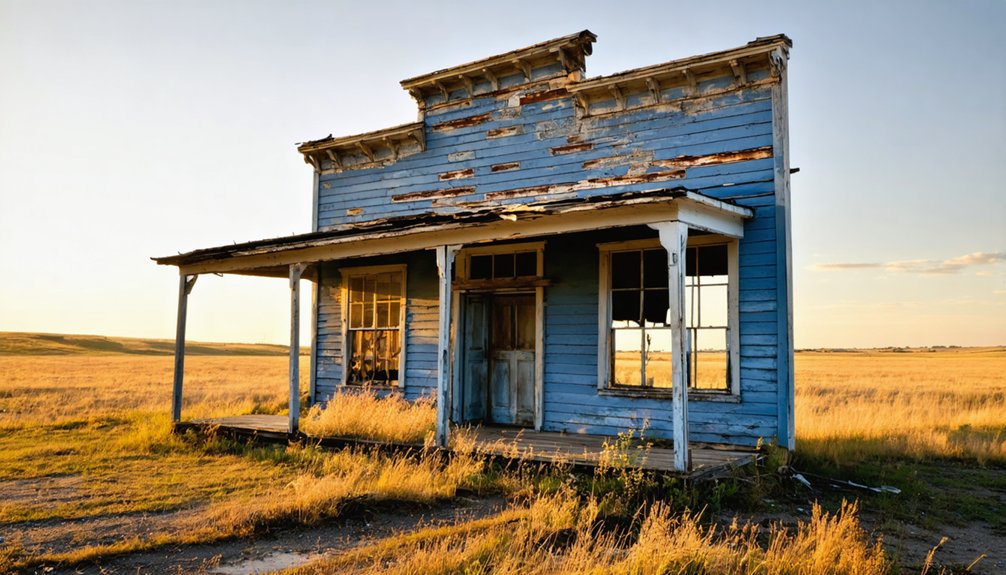You’ll find Allerton’s ghostly remnants in southeastern South Dakota, where David Kirk established this railroad town in 1884 during the Territory’s rail expansion. The town followed a classic T-shaped design around Main Street and the depot, peaking at 100 residents in the early 1900s. Today, abandoned tracks and crumbling grain elevators tell tales of derailed frontier dreams, while preservation efforts work to protect these fragments of prairie history that hold countless untold stories.
Key Takeaways
- Allerton was established in 1884 when David Kirk acquired land during railroad expansion in southeastern Dakota Territory.
- The town reached its peak population of approximately 100 residents in the early 1900s, centered around Main Street and the depot.
- Railroad jobs and agriculture drove the local economy, supported by shops, filling stations, churches, and schools.
- The town’s decline was primarily caused by shifting railroad routes, leading to its eventual abandonment and ghost town status.
- Abandoned buildings, overgrown railroad tracks, and crumbling foundations remain as evidence of Allerton’s frontier past.
The Railroad Origins and Early Settlement
While railroad expansion swept across southeastern Dakota Territory in the 1880s, Allerton’s story began with the Milwaukee Railway‘s strategic push through the region.
You’ll find this town’s roots firmly planted in 1884 when David Kirk acquired the initial land northwest of Dakota City. By 1886, railroad insider A.M. Bowdle took control, partnering with J.D. Lawler of the Chicago, St. Paul, and Milwaukee Railroad to shape the community’s destiny. Local speculators invested heavily in surrounding properties, anticipating the economic opportunities the railway would bring.
Like many towns of that era, Allerton’s layout followed the classic T-shaped design, with Main Street meeting the railroad tracks at the depot. The community thrived as rail mileage increased dramatically across eastern South Dakota between 1870-1885. Railroad influence extended beyond mere transportation – it determined everything from the placement of grain elevators to the location of essential businesses, creating a hub that would serve the surrounding agricultural community.
Life in Allerton’s Prime Years
During its prime years in the early 1900s, Allerton bustled with roughly 100 residents who built their lives around the railroad’s steady rhythm.
You’d find railroad workers heading to their shifts while ranchers tended to cattle and sheep in the surrounding plains. The town’s economic resilience came from this mix of railway jobs and agriculture, supported by local shops and filling stations. Just like the fur trading posts that came before, the town grew as a vital transportation hub.
Community activities centered on the Lutheran and Methodist churches, where you’d gather with neighbors for both worship and socializing. Like many towns that faced declining tourist traffic, Allerton’s shops gradually closed as transportation routes changed.
The local school served as another hub for town meetings and celebrations. Despite harsh South Dakota winters and occasional flooding, you’d experience a tight-knit community where everyone knew each other, bound together by their shared railroad and ranching lifestyle.
The Westward Migration Legacy
You’ll find Allerton’s abandoned railroad tracks and weathered grain elevators standing as silent witnesses to the westward migration dreams that once drew hopeful settlers to this South Dakota prairie.
Like many frontier towns born from railroad expansion, Allerton’s rise and fall mirrors the broader story of American mobility and settlement patterns in the late 19th century. Land companies developed towns along the tracks every seven miles to generate income and service steam locomotives.
The empty buildings and quiet streets tell a powerful tale of how quickly fortunes could change when railroad routes shifted and economic prospects dried up, leaving only memories of the bustling community that once thrived here. Similar to Trojan’s story, residents were forced to seek employment in larger towns like Lead or Deadwood as local opportunities vanished.
Railroad Dreams Die Hard
As railroad fever swept across southeastern Dakota Territory in the 1880s, ambitious speculators and railroad insiders played a high-stakes game of town building that would shape South Dakota’s future landscape.
You’d find characters like Alan Ladd’s father in Milltown and Alfred Wright in Dakota City, who’d gamble everything on the promise of incoming rail lines. They weren’t alone – savvy operators like A.M. Bowdle and J.D. Lawler used their railroad connections to acquire prime locations near proposed routes. The completion of the Transcontinental Railroad in 1869 had already shown how rail access could transform isolated areas into thriving communities.
But railroad dreams could turn to dust overnight. If you’d visited these speculative towns, you’d have seen the familiar “T-shape” layout with commercial streets leading to promised depots that sometimes never came. The Chicago, Burlington and Quincy railroad’s strategic decisions about where to build lines to serve mining and timber interests often determined which towns would thrive and which would fade away.
When the railroads chose different routes, these ambitious ventures withered, leaving behind ghost towns like Allerton – stark reminders of frontier dreams derailed.
Empty Prairie’s Silent Stories
Where settlers once dreamed of prosperous futures on South Dakota’s prairies, empty buildings now stand as silent witnesses to a vanished way of life. You’ll find their cultural significance etched in weathered grain elevators, abandoned churches, and crumbling storefronts – each telling historical narratives of pioneer determination. The wooden grain elevator at Okaton stands as a haunting reminder of the region’s agricultural heritage.
These remnants paint a stark picture of the challenges faced by early residents: harsh winters that tested their resolve, economic upheavals that shattered dreams, and the slow exodus as railroad lines pulled out and highways bypassed their communities. The Great Depression years drove many inhabitants toward urban centers seeking employment. When you walk these empty streets today, you’re stepping through layers of westward migration stories. The empty prairie doesn’t just whisper tales of failure – it speaks volumes about the courage, resilience, and adaptability of those who sought their fortune on these windswept plains.
Remnants of a Prairie Past
The crumbling wooden grain elevator stands as a silent sentinel over Okaton’s deserted landscape, its weathered frame missing its top section after decades of prairie winds and harsh South Dakota winters.
You’ll discover how settlement patterns shaped this once-bustling railroad town, now transformed into haunting cultural artifacts.
As you explore the remnants, you’ll find:
- Overgrown railroad tracks snaking through tall prairie grass
- Abandoned buildings that once housed determined homesteaders
- The old post office that served the community until 2013
- Vestiges of the Westlakes’ 1980s tourist attraction, including an empty rock shop
These physical remains tell the story of prairie pioneers who carved out lives along the Chicago, Milwaukee & St. Paul Railroad, their dreams eventually surrendering to economic hardship and changing times.
The Westlake Tourist Venture

During the 1980s, local entrepreneurs Jim and Mary Westlake envisioned transforming Allerton’s ghostly remains into a thriving tourist destination. Their ambitious plan included developing visitor facilities, interpretive trails, and exhibition spaces to showcase the town’s rich history.
The Westlake development impact reached beyond mere tourism dollars. You’ll find their influence in the carefully restored structures, informative signage, and the renewed sense of pride among nearby communities. They partnered with South Dakota tourism boards and leveraged social media to attract visitors from across the country.
Yet tourism sustainability challenges emerged. The venture faced seasonal fluctuations and the ongoing need to balance authenticity with commercial appeal.
Despite these hurdles, the project created jobs, stimulated local businesses, and established Allerton as more than just another abandoned prairie town.
Local Legends and Ghost Stories
If you’re exploring Allerton’s ghost stories, you’ll hear plenty about phantom railroad workers who still patrol the abandoned tracks and whistle in the darkness.
The town’s deserted buildings echo with unexplained footsteps and voices, particularly around the old mining facilities where workers once toiled.
Local legends tell of a mysterious woman in period dress who appears near the artesian wells, where she’s often spotted during the quietest hours of dawn and dusk.
Haunted Railroad Tales
Along abandoned railroad tracks near Allerton, South Dakota, ghostly tales of phantom trains and restless spirits have captivated locals for generations.
These spectral sightings often occur at night, when witnesses report seeing mysterious lights and hearing phantom whistles echoing across the prairie. The area’s rich history of train robberies, accidents, and tragedy has fueled stories of supernatural encounters that persist to this day.
- Ghostly engineers and conductors appear near former railway stations, perhaps still making their eternal rounds.
- Phantom locomotives materialize as floating lights, accompanied by unexplained track vibrations.
- Eerie whistles pierce the darkness where no trains have run for decades.
- Stories of vengeful spirits seeking justice for long-ago crimes against railway workers and passengers.
Whispers From Abandoned Buildings
When twilight descends on Allerton’s abandoned buildings, visitors report hearing unexplained whispers echoing through empty halls and vacant rooms.
You’ll find these spectral echoes most often in weathered structures that once housed early settlers and railroad workers. The whispering shadows seem to intensify as darkness falls, accompanied by sudden cold spots and mysterious footsteps on creaking floorboards.
Local folklore suggests these haunting phenomena stem from the town’s harsh past, where isolation and economic hardship left their mark.
You might catch glimpses of shadowy figures through broken windows of old churches and schoolhouses, while doors slam shut in empty homes without explanation.
Though no official paranormal investigations exist for Allerton specifically, these persistent tales mirror similar accounts throughout South Dakota’s ghost towns, preserving memories of those who once called these buildings home.
Architectural Heritage and Decay

While many South Dakota ghost towns have faded into history, Allerton’s architectural heritage tells a fascinating story of boom-and-bust cycles through its deteriorating structures.
You’ll find simple yet practical architectural styles reflecting the resourcefulness of early settlers who built with local materials. Like many ghost towns, Allerton faces significant preservation challenges from harsh weather and vandalism.
- Weather-worn wooden homes stand as silent witnesses to families who once called this place home.
- The town’s remaining structures showcase regional building techniques adapted for Dakota winters.
- Original stonework reveals the craftsmanship of early builders who shaped the town’s character.
- Empty doorways and broken windows tell stories of hasty departures when industry declined.
These architectural remnants aren’t just empty buildings – they’re chapters of South Dakota’s frontier spirit, waiting for you to discover their tales.
Environmental Challenges and Rural Exodus
Beyond Allerton’s weathered buildings lies a deeper story of environmental distress that reshaped the region’s destiny.
You’ll find the scars of uranium mining from the 1950s and ’60s still haunting the landscape, with arsenic and hazardous metals seeping into soil and groundwater near Cave Hills and Slim Buttes.
This environmental degradation forced many families to abandon their homes as unstable mine shafts created dangerous sinkholes beneath their feet.
The water crisis didn’t help either.
With Black Hills aquifers struggling to recharge and mining operations threatening what’s left of the clean water supply, you’re witnessing a perfect storm that accelerated rural migration.
Many folks simply couldn’t stick around when their wells ran dry and their land turned against them.
Those who stayed face an uphill battle against nature’s slow recovery.
Photography and Modern Tourism

If you’re planning to photograph Allerton’s historic remains, you’ll find the most compelling shots near the weathered grain elevator and abandoned storefronts, especially during golden hour just before sunset when shadows accentuate the textures of the deteriorating wood.
You’ll need to check in at the nearest inhabited property for permission before setting up your camera gear, as several structures sit on private land.
The best seasons for photography are spring and fall when the surrounding prairie grasses create a striking contrast against the rustic buildings, though you’ll want to keep a safe distance from unstable structures.
Best Photo Locations
The abandoned structures of Allerton offer photographers three distinct zones for capturing South Dakota’s haunting prairie history.
You’ll discover abandoned beauty around every corner, from weathered grain elevators to crumbling storefronts that tell stories of the town’s railroad glory days.
For the best nostalgia photography opportunities, explore these prime shooting locations:
- The historic wooden grain elevators, where low-angle shots create dramatic silhouettes against the prairie sky
- Railroad tracks leading into town, offering natural leading lines and perspective shots framed by overgrown vegetation
- Brick storefront ruins along Main Street, featuring textured walls and shadowed doorways perfect for moody compositions
- Abandoned wooden houses and jail, where warped timber and broken windows capture the essence of time’s passage
Seasonal Lighting Tips
Photography at Allerton takes on different characteristics as seasons change, demanding thoughtful approaches to lighting throughout the year.
You’ll find fall and winter’s low natural light levels require supplementary lighting to capture the ghost town’s weathered textures and haunting details.
For the best results, bring powerful LED flashlights and strobes with adjustable brightness. You’ll want to position your lights at 45° to 90° angles from your camera to enhance texture and create dramatic shadows.
During new moon periods, you’ve got perfect conditions for light painting – use your flashlights to selectively illuminate building facades while capturing starry backgrounds.
Don’t forget to pack extra batteries and weather-resistant gear, as winter’s cold can drain power quickly.
For a natural look, add warming gels to your lights to blend artificial illumination with the ambient seasonal lighting.
Ghost Town Access Rules
Before visiting Allerton’s haunting remains, you’ll need to familiarize yourself with essential access rules that protect both photographers and this historic site.
These visitor etiquette guidelines and access regulations guarantee you’ll explore responsibly while capturing the town’s historic charm.
- Don’t venture off designated paths or drive off-road – stick to marked trails to protect the fragile environment.
- Always obtain proper permits before commercial photography, especially if you’re planning to use professional equipment or props.
- Keep artifacts exactly where you find them – removing or disturbing historical items is strictly prohibited.
- Avoid sharing precise location details on social media to prevent vandalism, and consider bringing a companion for safety.
Preserving South Dakota’s Lost Towns
Preserving South Dakota’s ghost towns presents unique challenges, as many sites exist only through fragmented foundations and local memories.
You’ll find that ghost town preservation efforts rely heavily on historical societies and county registries to document these vanishing places, especially in the Black Hills region where over 600 abandoned settlements dot the landscape.
When you explore the state’s preservation initiatives, you’ll discover they’re not just about saving old buildings – they’re about protecting your cultural heritage.
The South Dakota State Historical Society maintains essential archives that tell the stories of these lost communities.
Through tax credits and grants, millions of dollars support historic rehabilitation programs that keep these remnants of the past alive.
These preservation efforts help maintain the authentic character that draws visitors to South Dakota’s historic sites year after year.
Frequently Asked Questions
Are There Any Descendants of Original Allerton Residents Still Living Nearby?
You’ll find few confirmed descendant stories, though local memories suggest some farming families in surrounding areas might have Allerton roots. Direct evidence is scarce, making it tough to verify.
What Was the Peak Population of Allerton During Its Most Prosperous Years?
While there’s no official historic population count, your best estimate for Allerton’s peak demographics would be 100-300 residents during its most prosperous years, typical of similar South Dakota railroad towns.
Did Any Famous Historical Figures Ever Visit or Stay in Allerton?
You won’t find any famous visitors in the records – there’s no documented evidence of historically significant figures ever staying there, despite the town’s existence during South Dakota’s early development.
What Specific Crops Were Primarily Grown by Allerton’s Early Farming Community?
Like pioneers breaking new ground, you’d find wheat cultivation dominated the local fields, with spring wheat being the primary crop, while corn farming played a significant but secondary role.
Was There Ever a Local Newspaper Published in Allerton?
You won’t find any record of local journalism coming from this town – available newspaper history shows residents likely relied on publications from nearby communities like Sisseton, Tabor and Scotland instead.
References
- https://www.legendsofamerica.com/sd-okaton/
- https://www.powderhouselodge.com/black-hills-attractions/fun-attractions/ghost-towns-of-western-south-dakota/
- https://www.youtube.com/watch?v=Glucs_Rq8Xs
- https://icatchshadows.com/okaton-and-cottonwood-a-photographic-visit-to-two-south-dakota-ghost-towns/
- https://www.blackhillsbadlands.com/blog/post/old-west-legends-mines-ghost-towns-route-reimagined/
- https://en.wikipedia.org/wiki/List_of_ghost_towns_in_South_Dakota
- https://freepages.history.rootsweb.com/~gtusa/usa/sd.htm
- https://www.onlyinyourstate.com/experiences/south-dakota/abandoned-neighborhood-sd
- https://www.atlasobscura.com/places/okaton-ghost-town
- https://www.ammhistory.com/The-Railroad-Part-1



